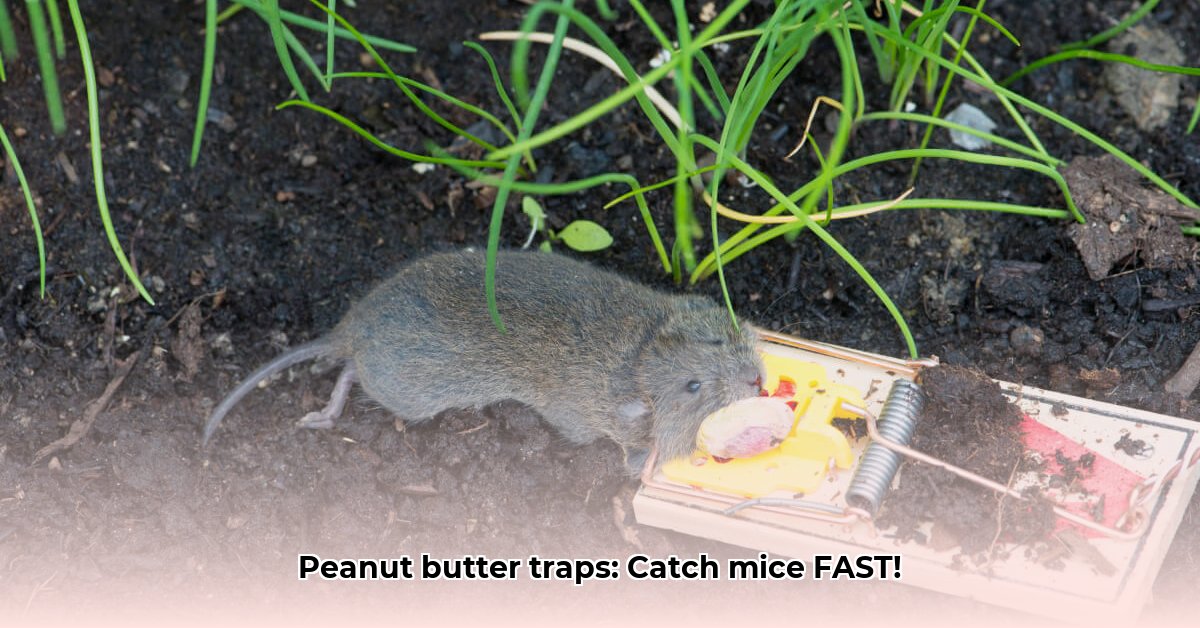Got mice? You’ve probably heard peanut butter works, and it’s true! Mice love it. For other pests, check out this guide on cabinet moth traps. This guide provides a comprehensive, step-by-step plan using peanut butter to catch mice, including trap selection, baiting techniques, strategic placement, and safe disposal. Whether you’re a first-timer or a seasoned DIYer, this guide will help you eliminate rodents quickly and safely.
Why Peanut Butter is a Mouse Magnet: The Science of Attraction
Why do mice adore peanut butter? It’s more than just taste. Understanding the science behind this attraction will give you a significant advantage in outsmarting these pests.
Aroma, Texture, and Reward: The Three Pillars of Mouse Attraction
Mice are drawn to peanut butter for a potent combination of reasons:
- Irresistible Aroma: The strong, nutty scent of peanut butter acts as a powerful signal, drawing mice in from a distance.
- Satisfying Texture and Nutrition: The rich, creamy texture, combined with its high fat and protein content, makes peanut butter a highly desirable and memorable food source. It provides them with essential nutrients.
- The Stickiness Factor: The sticky consistency prevents mice from easily stealing the bait without triggering the trap, increasing your chances of a successful catch.
Choosing Your Weapon: Selecting the Right Trap for Mouse Control
Selecting the right trap is crucial for effective mouse control. Different trap types offer varying advantages and disadvantages, depending on your situation and preferences:
| Trap Type | Pros | Cons |
|---|---|---|
| Snap Traps | Inexpensive, readily available at most hardware stores, effective for quickly eliminating individual mice, relatively humane when properly set and used, can be reused multiple times. | Requires careful placement to avoid accidental activation by children or pets, requires handling and disposal of the dead mouse, can be intimidating for some users. |
| Sticky Traps | Easy to set up and use, can catch multiple mice at once, can be used in areas where snap traps might be unsafe (e.g., around children or pets), relatively inexpensive. | Considered inhumane by some as mice can suffer for extended periods before dying, messy cleanup, potential for capturing non-target animals (e.g., insects, small reptiles), loses effectiveness in dusty or dirty environments. |
| Bucket Traps | Excellent for catching multiple mice, reusable, often considered more humane than snap or sticky traps, can be easily made at home with readily available materials, allows for catch-and-release (if desired), reduces the risk of injury to children and pets. | Requires more setup effort than other trap types, effectiveness depends on proper placement and baiting, may not be suitable for all locations. |
| Electronic Traps | Delivers a quick, humane kill with an electric shock, easy to use and clean, often features a no-see design for discreet rodent control, some models offer wireless notifications when a mouse is caught. | More expensive than traditional traps, requires batteries, must be kept dry to function properly. |
| Live Traps | Humane option for those who prefer catch-and-release, allows you to relocate mice to a more suitable environment, reusable and durable. | Requires regular monitoring and relocation of captured mice (at least a mile away from your property), mice may experience stress during capture and relocation, may not be effective for large infestations. |
Baiting Like a Pro: A Step-by-Step Guide to Preparing Your Traps
Follow this foolproof method for preparing your traps effectively and maximizing your chances of success:
- Gather Your Supplies: You’ll need your chosen trap(s), fresh peanut butter (smooth is generally preferred for its stickiness), disposable gloves, and cotton swabs or toothpicks.
- Prepare the Bait: Less is more! A pea-sized amount of peanut butter is usually sufficient. Too much bait can allow the mouse to eat without triggering the trap.
- Apply Strategically: Carefully apply the peanut butter to the designated bait area of the trap. For snap traps, focus on the trigger plate. For sticky traps, place a small dollop in the center. For bucket traps, smear it on the ramp leading to the bucket. Use a cotton swab or toothpick to avoid leaving your scent.
- Minimize Your Scent: Mice have a keen sense of smell. Always wear disposable gloves when handling traps and bait to prevent transferring your scent, which can deter mice.
- Inspect Regularly: Check your traps daily, or at least every other day. Dispose of any caught mice according to local regulations and reset the trap as needed. Replace the peanut butter if it becomes dry, hard, or moldy.
Thinking Like a Mouse: Strategic Trap Placement for Maximum Mouse Control
Effective trap placement is as important as the bait itself. To maximize your success, think like a mouse and consider these key points:
- Along Walls and Baseboards: Mice prefer to travel along walls and baseboards for safety, using them as guides. Place traps flush against walls with the trigger mechanism facing the wall.
- Near Known Food Sources: Identify potential food sources, such as crumbs, spills, pet food bowls, or improperly stored food. Place traps near these areas to intercept mice searching for a meal.
- Follow Mouse Trails: Look for signs of mouse activity, such as droppings, gnaw marks, or rub marks along walls. Place traps in areas where you observe the most activity.
- Near Entry Points: Identify and seal any potential entry points, such as cracks in the foundation, gaps around pipes, or holes in walls. Place traps near these entry points to catch mice as they enter your home.
- Consider the Environment: Avoid placing traps in areas where they could be disturbed or pose a hazard to children or pets.
Using more than one trap and covering a wider area will significantly increase your chances of catching mice quickly.
Mouse Control Safety First: Protecting Yourself, Your Family, and Your Pets
Safety is paramount when dealing with mouse traps. Follow these guidelines to protect yourself, your family, and your pets:
- Wear Gloves: Always wear disposable gloves when handling bait, traps, and dead mice to prevent the spread of disease.
- Keep Out of Reach: Place traps in areas that are inaccessible to children and pets. Consider using trap enclosures or bait stations to prevent accidental contact.
- Supervise Pets: If you have pets, monitor them closely around traps to ensure they don’t ingest the bait or get caught in the traps.
- Safe Disposal: Dispose of dead mice properly, following local regulations. Use gloves and a sealed plastic bag to prevent contact with the carcass.
- Wash Hands: After handling traps or bait, wash your hands thoroughly with soap and water.
Beyond Peanut Butter: Expanding Your Bait Options for Picky Eaters
While peanut butter is highly effective, some mice may develop a preference for other foods or become wary of it. Here are some alternative baits to try:
- Chocolate: Dark chocolate is particularly appealing to mice due to its strong aroma and high-fat content.
- Cheese: While not as universally effective as peanut butter, strong-smelling cheeses like cheddar or Parmesan can attract mice.
- Sweet Jams and Spreads: Fruit jams, Nutella, or other sweet spreads can be irresistible to mice with a sweet tooth.
- Bacon: Cooked bacon bits offer a savory alternative to sweeter baits.
- Pet Food: Small amounts of dry pet food can attract mice, especially if they are already feeding on it in your home.
Always ensure that any bait you use is safe for your family and pets and that you follow the same safety precautions as with peanut butter.
Sustained Control: Long-Term Solutions for a Mouse-Free Home
Trapping addresses the immediate mouse problem, but the best long-term solution involves proactive prevention:
- Seal Entry Points: Use caulk, steel wool, or expanding foam to seal any cracks, holes, or gaps in your foundation, walls, and around pipes. Pay particular attention to areas where utilities enter your home.
- Secure Food Storage: Store all food in airtight containers, including pantry items, pet food, and garbage. Clean up spills and crumbs promptly.
- Maintain Cleanliness: Regular cleaning, especially in the kitchen and pantry, minimizes potential food sources for mice.
- Reduce Clutter: Eliminate clutter, such as piles of boxes, papers, or clothing, that can provide nesting sites for mice.
- Landscaping: Keep grass and vegetation trimmed around your home’s foundation to reduce cover for mice.
A truly mouse-free environment comes through a combination of smart trapping and diligent prevention. Mice may love peanut butter, but a clean, well-maintained, and properly sealed home makes it far less tempting for them to stay.
Strategic Peanut Butter Use for Mouse Control Across Different Trap Types: A Detailed Breakdown
Here’s a comprehensive guide to using peanut butter effectively with various trap types:
Key Points:
- Peanut butter’s irresistible scent and taste are a major draw for mice.
- Using the right amount of peanut butter is crucial for trap effectiveness.
- Strategic trap placement is essential for maximizing your catch.
*
- Gluten Free Meal Prep Ideas for Delicious, Hassle-Free Eating - November 28, 2025
- Gluten Free Meal Prep for Stress-Free and Healthy Eating - November 27, 2025
- Quick And Easy Chicken Thigh Meal Prep For Weight Loss - November 26, 2025










